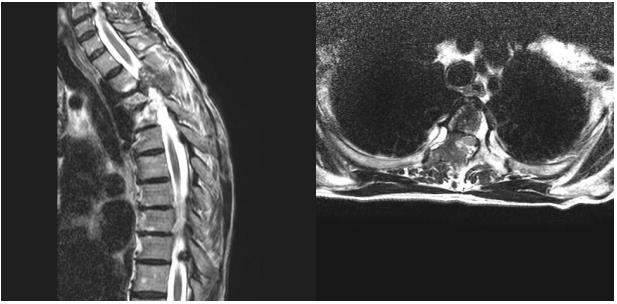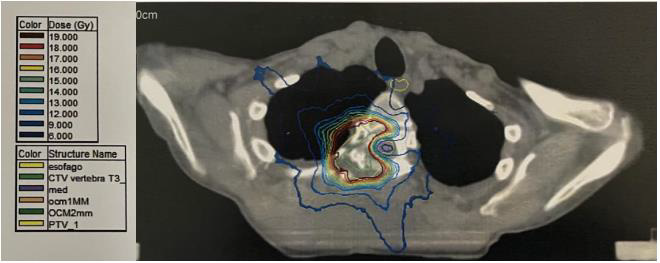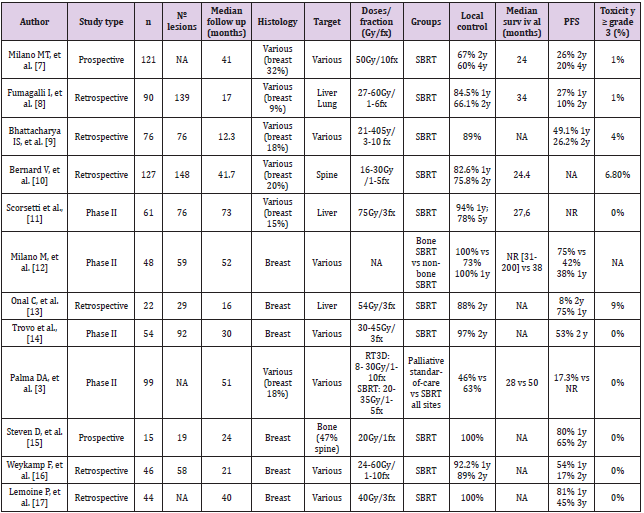Re-Irradiation Spine SBRT in Oligoprogression Breast Cancer: A Case Report
Introduction
The clinical state of oligometastases was first described by Hellman and Weichselbaum in the 1990s [1]. They suggested that there is an intermediate tumor stage between localized lesions and the widespread metastatic disease and proposed the concept of “oligometastatic disease” (OMD). Some studies have described OMD as a maximum of five treatable lesions. Recently, Guckenberger M, et al. redefined a new OMD classification system [2]. SBRT has experienced exponential development in recent years, as its ablative capacity has demonstrated a benefit in certain patients including OM and OP patients [3]. Oligoprogression is a limited tumor progression in some tumor sites with continued response or stable disease in other sites. SBRT allows the administration of high antitumor biologically effective doses. There are different dose fractionation schemes used depending on the anatomical location, size and tumor histology, among other factors. In general, the most common fractionation used in SBRT is over 6 Gy per fraction delivered 1-5 fractions. The radical treatment of metastatic lesions includes surgery, radiation therapy and combination therapies.
Case Presentation
We present a case of a 59-year-old woman with a history of infiltrating metastatic ductal carcinoma of the right breast. The subtypes of ER negative, PR 50%, Her2+ and ki-25% were identified at the time of diagnosis in March 2013. CT revealed multiple pulmonary and hepatic metastases. Prior to the diagnoses, the patient started systemic treatment with Navelbine given orally + Herceptin. Following two years with stable disease, on 15 January, CT revealed the progression of a unique bone metastasis of the vertebral column on vertebra T3. MRI confirmed the bone metastasis on the T3 right lateral vertebral body with bulging of the medullary canal. Given the oligoprogression of the disease, a radical treatment with SBRT was performed until reaching a dosage of 18 Gy in a single fraction of the T3 vertebral body at Hospital Vithas del Consuelo. The spinal cord received a maximum dose (Dmax, 0.01 cc) of 5.7Gy. Following treatment with SBRT, systemic treatment with Navelbine given orally and Herceptin resumed. In February 2019, follow up with CT indicated local progression of the previously treated lesion on vertebra T3. An MRI was performed showing an osteolytic lesion in T3 affecting the body, pedicle, and right lamina, with an extradural tumor mass occupying the spinal canal in 50% of T3 and medullary compression/deviation from right to left (Figure 1). Based on these findings, the tumor in the spinal canal was resected, with subsequent post-operative SBRT on the surgical site.
Figure 1: These images represent vertebral metastases before SBRT.
a) Saggital plane MRI before treatment.
b) Axial plane MRI before treatment.
On 1 March 2019, the extradural intra-spinal tumor mass was resected, decompressing the spinal cord and separating it from the surgical site using two Teflon sheets (the sheets surrounded the thecal sac). The postoperative period was without complications. After the resection, on 25 March 2019, SBRT was performed on the surgical site of the D3 vertebra. Fixation and immobilization were carried out using a body stereotaxic frame (BodyFix®, Elekta). The simulation was performed by CT and MRI. IRMT was used with stereotaxic coordinates on the tumor bed until reaching a dosage of 18 Gy in a single fraction (Figure 2). The spinal cord received a maximum dose (Dmax, 0.01 cc) of 7.3Gy. Following treatment with SBRT, the patient resumed systemic treatment with Navelbine given orally and Herceptin resumed. As of the last follow-up on 25 October 2021, the patient remained stable, with no evidence of local or distant progression.
Discussion and Results
Breast cancer (BC) is the most common cancer in women, with 2,26 million estimated new BC cases worldwide in 2020 [4]. Bone is the most common site of metastasis for BC [5]. Nevertheless, metastasis confined to the bone have a more favorable prognosis than other types of distant metastasis [6]. As we previously mentioned, SBRT and its ablative ability offers a greater tumor control compared to conventional palliative radiotherapy (CPR) [3]. A non-systematic review has been carried out on the topic of SBRT targeting oligometastases in BC. Table 1 summarizes the publications reviewed from PubMed database within the last 10 years. The potential benefit of SBRT in oligometastatic BC has increased the evidence supporting local control (LC), overall survival (OS) and progression free survival (PFS) in these patients. After this review, 12 articles were included, four of them were randomized clinical trials (RCT) [3,7-9], 2 were prospective studies [10,11] and 5 were retrospective studies [12-17]. The sample size is remarkably different among studies ranging from 22 to 227 patients. The follow-up is also distinct ranging from 17 to 73 months. Furthermore, 6 out of 12 articles include multiple histologies [3,7,10,12-14]. LC after SBRT is achieved in 60 to 100% of the cases [10,11], and OS varies from 24 to 50 months [3,18]. When focusing on studies including only BC patients [8,15,9,11,16,17] LC varies from 73% to 100% [8,11].
Table 1: A review of the different retrospective and prospective trials of SBRT in oligometastases breast cancer.
OS median ranges from 28 to 50 months and it was not reached in one of the studies [8]. PFS varies from 38 to 81% [15,9,16,17] and 2-year PFS from 17,3 to 65% [3,11]. A single study included exclusively bone lesions (47% spine metastases) in BC patients [11]. This prospective study reports up to 100% LC rates and a 2-year PFS of 65% of bone metastases treated with radiosurgery (20Gy in 1 fraction) [11]. Milano M et al. demonstrated a better LC (100% vs. 73%), OS (not reached vs 38 months; p=0.002) and PFS (75% vs 42%) after the treatment of extracranial bone lesions compared to those not involving the skeleton (adrenal gland, liver, lung or lymph nodes) [8]. Other authors also report differences in terms of LC depending on the target [3]. Palma et al. reported an improvement in LC (46% vs 63%; p<0.05) and OS (28% vs 50%; p<0.05) after SBRT to all metastatic sites compared to CPR standard-of-care in oligometastatic patients. No increase in toxicity was observed after SBRT [3]. In this context, Sprave and collegues showed no detriment in the quality of life (assessed through QOLBM22, QLQ FA13 and QSC-R10) following SBRT compared to CPR in vertebral metastatic lesions [19]. Grade 3 or higher toxicity reported in the articles reviewed ranges from 0% to 9%. In patients with spinal instability, cord compression, or neurologic deficits, the standard of care is surgery followed by radiation therapy.
Some authors report excellent results with the use of SBRT in patients who have undergone surgical intervention for spine metastases [19,20]. Separation surgery, as our case, refers to providing sufficient surgical circumferential decompression of the spinal cord to create at least 1–2 mm of space between the spinal cord and disease to optimize the SBRT dose distribution. SBRT in oligometastatic patients shows favorable results. In our patient, after radical surgical treatment and SBRT, a complete response was achieved. After more than two years of follow-up the patient remains with neither local nor distant recurrence. Finally, we have to consider that the studies reviewed show heterogeneity both in the target location and treatment site (lung, liver, bone…). Owing to the limitations mentioned above, few robust conclusions can be drawn to the date. There are currently several ongoing clinical trials, such as NRG BR002 (NCT02364557), AVATAR (ACTRN12620001212943) [21] or STEREO-OS (NCT03143322) [19], that will provide more data in relation to the SBRT in oligometastatic BC patients [22,23].
Conclusion
Patients with oligometastatic or oligoprogressive breast cancer are candidates for radical treatment modalities. SBRT has demonstrated promising LC, PFS and OS in these patients with an acceptable toxicity. In this context, there are currently ongoing phase III studies in order to provide stronger evidence.





No comments:
Post a Comment
Note: Only a member of this blog may post a comment.